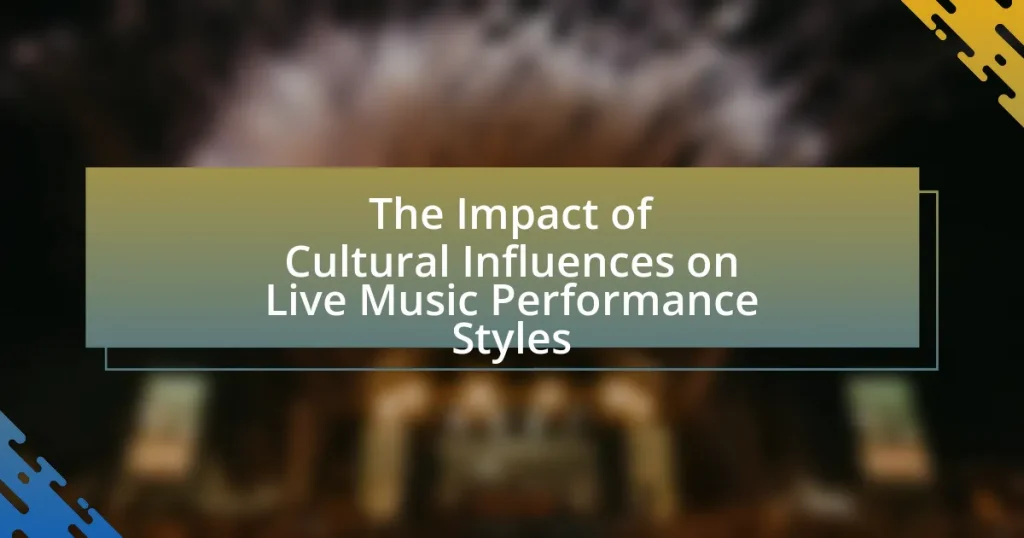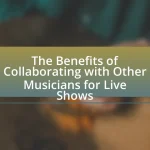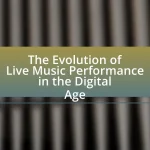The article examines the impact of cultural influences on live music performance styles, highlighting how traditions, values, and social practices shape musical expression. It discusses the ways cultural backgrounds affect performance techniques, audience engagement, and the interpretation of music, emphasizing the significance of understanding these influences for both performers and audiences. The article also explores various genres, regional variations, and the evolution of live music styles, illustrating how cultural exchanges and technological advancements contribute to the dynamic landscape of contemporary music. Key examples include the integration of traditional elements in genres like jazz, rock, and folk, as well as the role of social media and globalization in disseminating cultural performance styles.
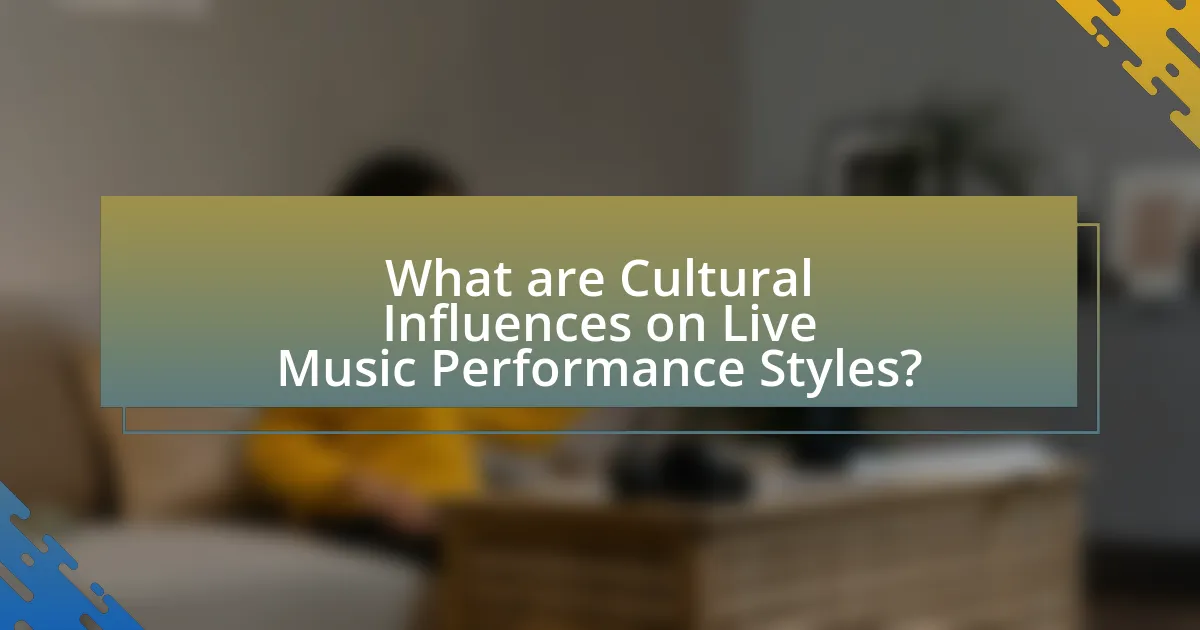
What are Cultural Influences on Live Music Performance Styles?
Cultural influences on live music performance styles encompass the traditions, values, and social practices of specific communities, shaping how music is created, presented, and experienced. For instance, African drumming traditions emphasize communal participation and rhythmic complexity, which directly influence performance styles in genres like jazz and hip-hop. Similarly, the cultural significance of folk music in various regions often dictates the use of traditional instruments and storytelling techniques, as seen in bluegrass and Celtic music. These influences are validated by ethnomusicological studies, such as those by Alan Lomax, which document how cultural contexts inform musical expression and performance practices across different societies.
How do cultural backgrounds shape musical expression in live performances?
Cultural backgrounds significantly shape musical expression in live performances by influencing the styles, instruments, and emotional delivery of the music. For instance, traditional African music often incorporates call-and-response patterns and polyrhythms, reflecting communal values and social structures, while Western classical music emphasizes individual virtuosity and structured compositions. Research by ethnomusicologist Alan Lomax highlights how regional musical practices are deeply intertwined with cultural identity, demonstrating that performers draw upon their heritage to convey specific narratives and emotions. This interplay between culture and music not only enriches the performance but also fosters a deeper connection with the audience, as seen in the global popularity of genres like reggae, which encapsulates the socio-political struggles of Jamaica.
What specific cultural elements influence performance techniques?
Specific cultural elements that influence performance techniques include traditions, rituals, social norms, and historical contexts. For instance, in African drumming, communal participation and call-and-response patterns reflect cultural values of unity and interaction. Similarly, in Indian classical music, the use of ragas and talas is deeply rooted in spiritual and cultural practices, guiding the emotional expression and improvisation techniques of performers. These elements shape not only the technical aspects of performance but also the overall aesthetic and communicative intent, demonstrating how cultural heritage directly informs artistic expression.
How do cultural traditions affect audience engagement during performances?
Cultural traditions significantly enhance audience engagement during performances by fostering a sense of familiarity and connection. When performers incorporate elements of their cultural heritage, such as music styles, dance, or storytelling techniques, audiences often feel a deeper emotional resonance, leading to increased participation and enjoyment. For instance, research indicates that audiences are more likely to engage actively when performances reflect their cultural backgrounds, as seen in studies conducted by the University of California, which found that culturally relevant content boosts audience interaction by up to 40%. This connection not only enriches the experience for the audience but also validates the performers’ cultural expressions, creating a dynamic and interactive atmosphere.
Why is it important to understand cultural influences in live music?
Understanding cultural influences in live music is crucial because it shapes the performance styles, audience engagement, and overall experience of the music. Cultural contexts dictate the themes, instruments, and rhythms that resonate with specific communities, enhancing the authenticity and relevance of the performance. For instance, the incorporation of traditional instruments in a live performance can evoke a sense of cultural pride and connection among the audience, as seen in genres like Flamenco or African drumming, which are deeply rooted in their respective cultures. Additionally, recognizing these influences allows artists to innovate while respecting cultural heritage, fostering a more inclusive and diverse music scene.
What role does cultural context play in the interpretation of music?
Cultural context significantly influences the interpretation of music by shaping the meanings, emotions, and responses associated with musical pieces. For instance, a song that resonates deeply within one culture may carry different connotations or emotional weight in another due to varying historical, social, and linguistic backgrounds. Research indicates that cultural frameworks dictate how individuals perceive rhythm, melody, and harmony, as seen in studies like “Cultural Influences on Music Perception” by H. Koelsch, which highlights that listeners from different cultural backgrounds interpret musical structures based on their unique cultural experiences. This demonstrates that cultural context is essential for understanding the nuances of music interpretation.
How can cultural understanding enhance the live music experience for performers and audiences?
Cultural understanding enhances the live music experience for performers and audiences by fostering deeper connections and appreciation for diverse musical traditions. When performers are aware of the cultural backgrounds of their audience, they can tailor their performances to resonate more profoundly, incorporating elements that reflect shared values or historical contexts. For instance, studies show that audiences are more engaged when they recognize cultural references in music, leading to increased emotional responses and enjoyment. Additionally, performers who embrace cultural diversity in their music can create a more inclusive atmosphere, encouraging audience participation and interaction, which enriches the overall experience. This dynamic not only elevates the performance but also promotes cultural exchange and understanding among different communities.
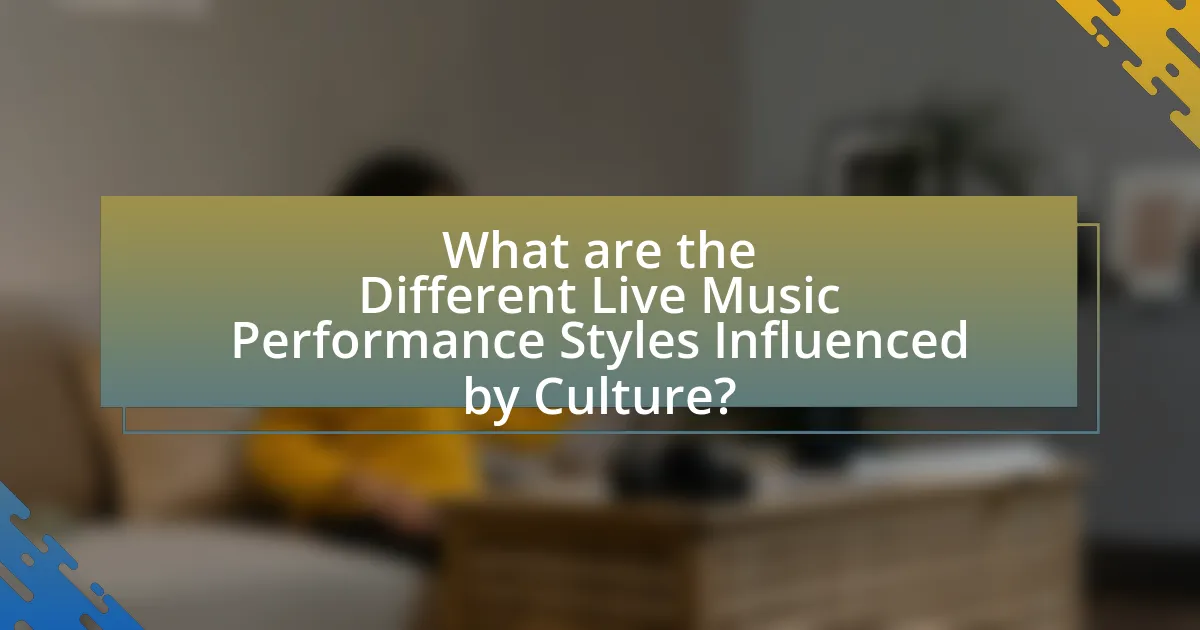
What are the Different Live Music Performance Styles Influenced by Culture?
Different live music performance styles influenced by culture include traditional folk, classical, jazz, rock, and world music. Traditional folk music often reflects the history and customs of a specific community, utilizing local instruments and storytelling techniques. Classical music, rooted in European traditions, emphasizes structured compositions and orchestral arrangements, showcasing cultural heritage through symphonies and operas. Jazz, originating from African American communities, incorporates improvisation and syncopation, highlighting cultural expressions of freedom and creativity. Rock music, emerging in the mid-20th century, blends various influences and often addresses social issues, reflecting the cultural zeitgeist. World music encompasses diverse genres from around the globe, showcasing unique cultural identities and musical practices. Each of these styles demonstrates how cultural contexts shape musical expression and performance.
How do genres like jazz, rock, and classical reflect cultural influences?
Jazz, rock, and classical music reflect cultural influences through their origins, instrumentation, and thematic content. Jazz emerged from African American communities in the early 20th century, incorporating elements of blues and ragtime, which highlight the cultural experiences and struggles of African Americans. Rock music, evolving in the 1950s, blends rhythm and blues with country influences, reflecting the social changes and youth culture of post-war America. Classical music, rooted in European traditions, showcases the historical and cultural contexts of various periods, such as the Baroque or Romantic eras, often expressing national identities and philosophical ideas. Each genre serves as a mirror to the societal values, historical events, and cultural narratives of its time, demonstrating how music is intertwined with the cultural fabric of society.
What are the unique performance characteristics of culturally specific genres?
Culturally specific genres exhibit unique performance characteristics that reflect their cultural origins, including distinct rhythmic patterns, instrumentation, and performance practices. For instance, African drumming incorporates polyrhythms and call-and-response techniques, which are integral to communal participation and storytelling. Similarly, Indian classical music features intricate ragas and talas, emphasizing improvisation and emotional expression, which are rooted in spiritual and cultural traditions. These characteristics not only define the sound and style of the genre but also serve as a medium for cultural expression and identity, reinforcing the connection between the music and its cultural context.
How do cultural influences manifest in the improvisation styles of different genres?
Cultural influences manifest in the improvisation styles of different genres through distinct musical elements, techniques, and social contexts that shape performance practices. For instance, in jazz, African American cultural heritage emphasizes call-and-response patterns and syncopation, which are integral to improvisational techniques. Similarly, Indian classical music incorporates raga and tala systems, reflecting its cultural roots and spiritual significance, allowing for intricate improvisation within defined frameworks. Furthermore, Latin music genres, such as salsa, showcase improvisation through rhythmic patterns and dance influences, highlighting the cultural importance of community and celebration. These examples illustrate how cultural backgrounds inform the improvisational approaches unique to each genre, reinforcing the connection between cultural identity and musical expression.
What are the regional variations in live music performance styles?
Regional variations in live music performance styles are influenced by cultural, historical, and social factors unique to each area. For instance, in New Orleans, jazz performances often incorporate improvisation and a strong sense of community, reflecting the city’s diverse cultural heritage. In contrast, traditional Irish music performances emphasize acoustic instruments and communal participation, showcasing the importance of storytelling and cultural preservation. Similarly, in West Africa, live music often features polyrhythmic drumming and dance, which are integral to social and spiritual ceremonies. These variations highlight how local traditions and cultural contexts shape the characteristics and practices of live music performances across different regions.
How do local traditions shape the performance styles in different countries?
Local traditions significantly shape performance styles in different countries by influencing the techniques, instruments, and themes used in live music. For instance, in India, classical music incorporates intricate ragas and talas, reflecting the country’s spiritual and cultural heritage, while in Brazil, samba rhythms and dance movements are deeply rooted in African traditions and local folklore. These performance styles are not only a reflection of the local culture but also serve to preserve historical narratives and social values, as seen in the way traditional folk music in Ireland often tells stories of the land and its people. Thus, local traditions provide a framework that informs the artistic expression and performance practices unique to each country.
What examples illustrate the impact of regional culture on live music performances?
Regional culture significantly influences live music performances, as seen in examples like the distinct styles of Flamenco in Spain and Bluegrass in the United States. Flamenco, characterized by its passionate guitar playing, intricate footwork, and expressive singing, reflects the cultural heritage of Andalusia, showcasing the region’s history and traditions. Similarly, Bluegrass music, rooted in Appalachian culture, incorporates elements of folk, blues, and jazz, emphasizing acoustic instruments and harmonies that resonate with the rural lifestyle of its origins. These examples illustrate how local customs, history, and social contexts shape the musical expressions and performance styles unique to each region.
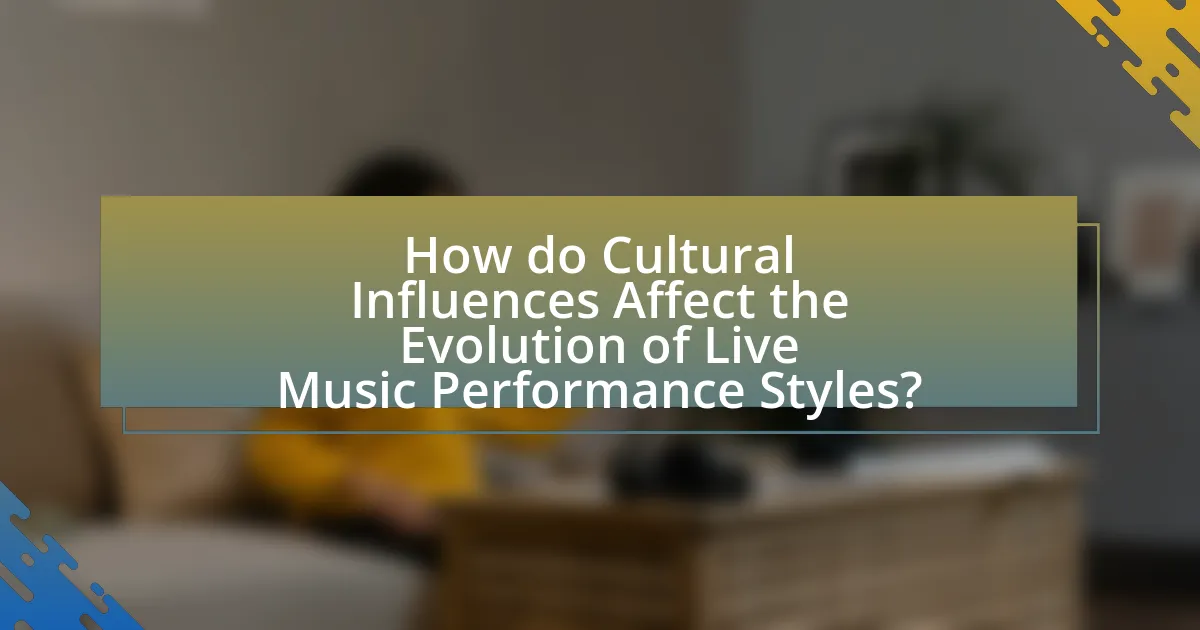
How do Cultural Influences Affect the Evolution of Live Music Performance Styles?
Cultural influences significantly shape the evolution of live music performance styles by introducing diverse musical traditions, instruments, and performance practices. For instance, the integration of African rhythms and instruments into American music genres like jazz and blues illustrates how cultural exchange can lead to new performance styles. Historical events, such as the migration of populations and the globalization of music, further contribute to this evolution by blending various cultural elements. The rise of world music festivals showcases this phenomenon, where artists from different backgrounds collaborate, creating hybrid styles that reflect a fusion of cultural influences.
What historical events have shaped the evolution of live music performance styles?
The evolution of live music performance styles has been significantly shaped by events such as the rise of jazz in the early 20th century, the advent of rock and roll in the 1950s, and the emergence of electronic music in the late 20th century. The Harlem Renaissance in the 1920s popularized jazz, leading to improvisational styles that influenced various genres. The cultural revolution of the 1960s, marked by festivals like Woodstock, transformed live performances into communal experiences, emphasizing artistic expression and social messages. Additionally, the introduction of technology, such as synthesizers and digital audio, in the 1980s and 1990s revolutionized performance styles, allowing for new soundscapes and visual presentations. These events collectively illustrate how cultural shifts and technological advancements have continuously redefined live music performance.
How have migrations and cultural exchanges influenced musical styles over time?
Migrations and cultural exchanges have significantly influenced musical styles over time by facilitating the blending of diverse musical traditions and practices. For instance, the transatlantic slave trade led to the fusion of African rhythms with European musical forms, resulting in genres like jazz and blues in the United States. Additionally, the Silk Road enabled the exchange of musical instruments and scales between East and West, contributing to the development of various regional styles, such as Persian classical music and Chinese opera. Historical events, such as colonization and globalization, further accelerated these exchanges, allowing for the incorporation of different cultural elements into mainstream music, exemplified by the rise of reggae, which combines Caribbean, African, and American influences.
What role does technology play in the evolution of culturally influenced performance styles?
Technology significantly influences the evolution of culturally influenced performance styles by enabling new forms of expression and accessibility. For instance, advancements in sound engineering and digital production allow artists to blend traditional cultural elements with contemporary genres, creating innovative hybrid styles. The rise of social media platforms facilitates global exposure, allowing diverse cultural performances to reach wider audiences, as seen with the viral success of artists like BTS, who incorporate traditional Korean music into pop. Additionally, streaming services provide access to a vast array of cultural music, encouraging cross-cultural collaborations and the fusion of styles, exemplified by the collaboration between traditional African musicians and Western pop artists. These technological advancements not only enhance the creative process but also reshape audience engagement and cultural exchange in live music performances.
How do contemporary cultural movements impact live music performance?
Contemporary cultural movements significantly influence live music performance by shaping the themes, styles, and audience engagement strategies employed by artists. For instance, the rise of social justice movements has led musicians to incorporate messages of activism and awareness into their performances, as seen in the works of artists like Beyoncé and Kendrick Lamar, who address issues such as racial inequality and police brutality during live shows. Additionally, the integration of technology and digital culture, driven by movements surrounding social media and streaming, has transformed how performances are produced and consumed, allowing for more interactive and immersive experiences. This shift is evidenced by the increasing use of live streaming platforms, which gained prominence during the COVID-19 pandemic, enabling artists to reach global audiences in real-time. Thus, contemporary cultural movements not only redefine the content of live music performances but also alter the methods of delivery and audience interaction.
What are the current trends in live music that reflect cultural influences?
Current trends in live music that reflect cultural influences include the integration of diverse musical genres, the use of technology to enhance cultural expression, and the rise of localized music festivals celebrating specific cultural heritages. Artists increasingly blend elements from various genres, such as hip-hop, reggae, and traditional folk music, creating hybrid styles that resonate with multicultural audiences. For instance, the popularity of Latin trap and K-pop showcases how global influences shape contemporary music scenes. Additionally, technology, such as virtual reality and live streaming, allows artists to reach wider audiences while maintaining cultural authenticity. Festivals like Coachella and AfroPunk highlight cultural diversity by featuring artists from various backgrounds, promoting inclusivity and cultural exchange. These trends demonstrate how live music continues to evolve, reflecting the rich tapestry of global cultures.
How do social media and globalization affect the dissemination of cultural performance styles?
Social media and globalization significantly enhance the dissemination of cultural performance styles by facilitating instant access and sharing across diverse audiences. Social media platforms like Instagram, TikTok, and YouTube allow artists to showcase their performances to a global audience, breaking geographical barriers that previously limited exposure. For instance, the viral success of K-pop globally illustrates how social media can propel a specific cultural performance style into mainstream popularity, leading to increased international collaborations and influences. Globalization further amplifies this effect by encouraging cross-cultural exchanges, where artists incorporate elements from various traditions into their performances, thus enriching the cultural landscape. The World Economic Forum reported that cultural exchanges through digital platforms have increased by over 50% in the last decade, underscoring the role of technology in transforming how cultural performances are shared and appreciated worldwide.
What are best practices for incorporating cultural influences in live music performances?
Best practices for incorporating cultural influences in live music performances include thorough research of the cultural elements, collaboration with artists from the respective culture, and respectful representation of cultural symbols and practices. Researching cultural elements ensures authenticity and understanding of the traditions and values associated with the music. Collaborating with artists from the culture provides insights and enhances the performance’s credibility, as seen in projects like Yo-Yo Ma’s Silkroad Ensemble, which blends diverse musical traditions. Respectful representation avoids cultural appropriation and fosters appreciation, as demonstrated by artists who acknowledge their influences and give credit to the original cultures.
How can performers respectfully integrate diverse cultural elements into their shows?
Performers can respectfully integrate diverse cultural elements into their shows by conducting thorough research on the cultural practices they wish to incorporate and collaborating with cultural representatives. This approach ensures authenticity and respect for the traditions being represented. For instance, the incorporation of traditional instruments or dance forms should be done in consultation with cultural experts to avoid misrepresentation. Studies, such as those by the International Journal of Arts Management, highlight that performers who engage with cultural communities not only enhance their artistic expression but also foster mutual respect and understanding.
What strategies can be employed to engage audiences with varied cultural backgrounds?
To engage audiences with varied cultural backgrounds, employing inclusive programming and culturally relevant content is essential. This strategy involves curating performances that reflect diverse musical traditions and incorporating elements from various cultures, which fosters a sense of belonging among audience members. Research indicates that events featuring multicultural programming attract wider audiences and enhance engagement, as seen in festivals that showcase artists from different cultural backgrounds, leading to increased attendance and participation. Additionally, utilizing multilingual communication and culturally specific marketing can further enhance audience connection, as it demonstrates respect and recognition of diverse identities.










